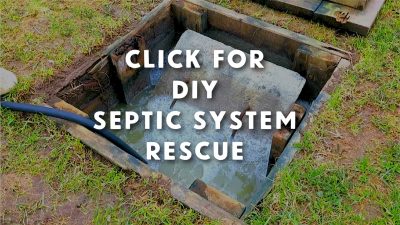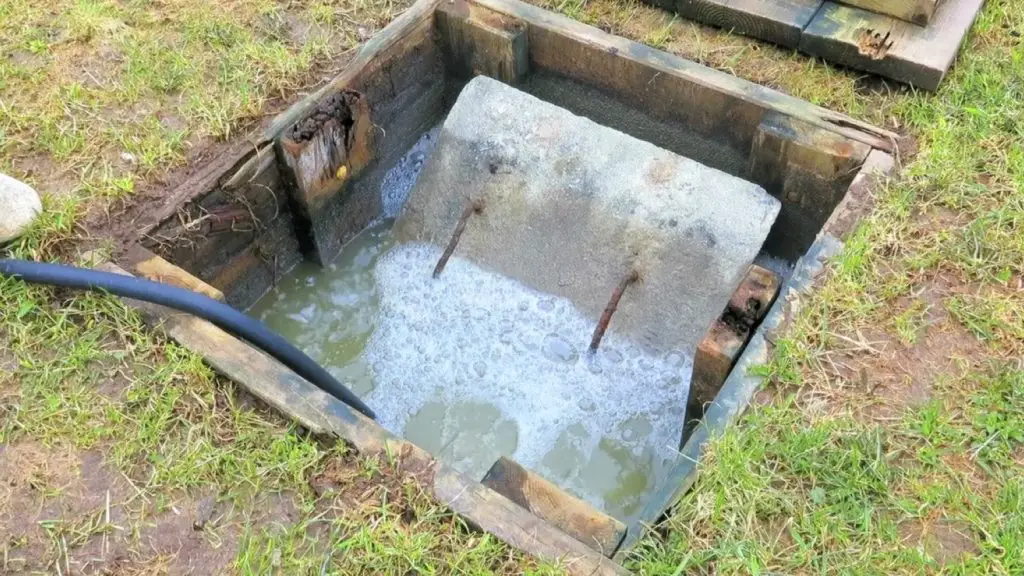UPDATED 10Jul2020 + video: If you rely on a septic system, or if your septic system is currently showing signs of failure, you’ve come to the right place. You don’t necessarily need a whole new system. In fact, you probably don’t. This article is all about how I fixed my very sick septic system myself, with no professional help, and how I’ve helped other hundreds of other people to do the same. The photo below shows my failed septic system at the height of its failure. The liquid you see is about 8 inches above the top of the tank, and almost 24″ higher than the level of sewage should be. A licensed septic system installer examined my system and pronounced it unsalvageable.
This is my septic system in the middle of a total failure in 2011. I revived the system myself with no fancy equipment and very little disruption. It’s been working fine ever since.Millions of people rely on septic systems to handle household waste water, and all these systems are an expensive time bomb waiting to explode. It’s not a matter of if your septic system will fail, but when the thing will stop working. This is true even if you have your system pumped out every 2 or 3 years. No septic system works forever, or at least that’s what I used to think. The real issue is what do you do when you find your septic system backing up.
A Bad Dady for My Septic System
The septic system time bomb blew up at my place on June 17th, 2011. As you can see in the photo above, the sewage was way above the top of the tank as the main access hatch is removed. The thing is, the solution I found for getting my system working again turned out to be cheaper, easier and far less disruptive than what I feared. Now its July 2020 and my system is still working perfectly. In fact, it’s as good as new. The longest operational life of a septic system that I’ve ever heard of so far is 39 years. The shortest is 5 years. Mine crapped out (literally) after 22 years of service, but since I completely revived it we’re now in our 30th year of service. To understand why typical septic system failure is only a matter of time (and how it can be different for you) you need to understand how these hidden and mysterious sewage systems work, why they’re susceptible to trouble and what you can do to avoid grief or eliminate it when it comes. The details won’t be pretty, but if you’ve got a septic system in your life, this information is very much worth knowing about. Click below to watch and learn.
How Septic Systems Work
Typical septic systems begin with an underground tank that’s divided in two. Raw sewage comes from your house and enters the first half of the tank. Digestion begins here, allowing most of the solids to become liquefied. Indigestible solids settle out on the bottom of this first half of the tank. Liquid effluent flows to the second half of the tank where more digestion happens before the liquid moves out into perforated pipes buried below soil level downstream of the tank. This area of soil is called the weeping bed or leaching bed, and it’s the most vulnerable part of any septic system. I’m told that 90% of the purification of waste water happens as the roots of grass and other green plants feed on the effluent, and I’m inclined to believe it. I can tell you from observation that the water in the second half of a septic tank is far from pure, while samples of water taken from the far end of a weeping bed are clear and odour free. At least until the weeping bed stops working, that is.
The problem with septic systems is that the small round stones and soil around the perforated, underground pipes in the leaching bed eventually stop allowing liquid to flow through it. Failure to pump out your septic tank every two or three years is one reason this might happen sooner than it should. I’ve also been told by more than one septic system installer that powdered laundry detergent is much more likely to cause a plugged weeping bed than liquid detergent. Laundry lint can cause problems in some cases too, but so can ordinary, everyday use of your septic system. In fact, even with careful use and diligent pump outs, the stone and soil immediately around the buried, perforated pipes will eventually become colonized with a growth of slimy, impervious microbes, developing what’s called a “biomat” that stops water from seeping away. Regardless of the cause of septic system clogging, the effect is the same. Nasty fluid backs up and overflows from the tank as outflow of sewage can’t keep up with inflow. This is what happened at my place back in 2011, and it’s the point where things usually get very expensive and very messy, though it doesn’t have to.
I first noticed problems when I lifted the lids off of the wooden boxes I’d built over my septic tank to make access easier for pump outs. There was a faint odour of sewage in the area at the time, and I knew this meant trouble. That’s when I saw 12 inches of sewage sitting on top of the concrete septic tank. That’s about two feet higher than the level should have been if proper drainage was happening, and I braced myself for the $10K job of tearing up my weeping bed with a backhoe, pulling out the old pipes and impervious soil, then replacing everything and waiting two or three years for the grass to get back to normal. Yikes! Ten thousands dollars is easy to spend on a new septic system, not to mention the additional inspection and certification requirements that some places impose on homeowners with new septic systems. While your existing system will be grandfathered and not require regular inspections, the moment you get a new system you might need to pay a couple of hundred dollars a year to have a uniformed expert come out and make sure your system is working to municipal standards. With these kind of stakes involved, it prompted me to take a gamble that I discovered online.
After hoping in vain that my problem was a clogged tank outlet hole (it does happen sometimes, but not this time for me) I did a Google search for “clogged septic systems”. I knew alternatives to a complete weeping bed rebuild existed, and I hoped to find one that looked promising enough to try. In the end I did. It cost more than $400, but it didn’t deliver lasting benefits.
Normally, I wouldn’t spend $419 on a couple of pounds of bluish green powder, but it was the promise behind the product and the costly and messy alternative that made me try. The product I bought is called SeptiCleanse, and it’s touted as a bacterial culture that’s specially bred to eat the disgusting, slimy stuff that stops weeping beds from working. You flush packets down the toilet (the powder is contained in water soluble, plastic-like bags), it inoculates the sewage in the tank, and the microbes multiply, happily eating gunk and getting things flowing again. That’s the theory.
At the time I bought SeptiCleanse I was led to believe that it came with a money-back guarantee. In practice this was not the case. When I asked for a refund after the first heavy duty treatment didn’t work, the SeptiCleanse person told me they’d send another treatment. No money, just more powder. After that second treatment didn’t work, they sent me another “heavy duty” treatment. That didn’t work either and still no refund was extended to me. Eventually, I gave up and considered the whole thing a loss after more than half a year of trying.
 As I mentioned before, after hobbling along and trying in vain to fix my bad system, I did get things working properly and it’s been doing fine for years now, even with 5 to 7 people living in the house at any given time. Naturally, I’m very happy (and quite a bit better off financially). The process I used didn’t involve any magic powder and hocus-pocus in the septic tank either, just good common sense applied to a method for maintaining the all-important leaching bed. I believe this kind of leaching bed maintenance is key. And I guess it’s no mystery that septic system installers don’t build leaching beds to be maintained. But that’s okay. It’s the kind of thing that can be retrofitted by any handy homeowner who wants to avoid the kind of septic system failure that’s normally inevitable.
As I mentioned before, after hobbling along and trying in vain to fix my bad system, I did get things working properly and it’s been doing fine for years now, even with 5 to 7 people living in the house at any given time. Naturally, I’m very happy (and quite a bit better off financially). The process I used didn’t involve any magic powder and hocus-pocus in the septic tank either, just good common sense applied to a method for maintaining the all-important leaching bed. I believe this kind of leaching bed maintenance is key. And I guess it’s no mystery that septic system installers don’t build leaching beds to be maintained. But that’s okay. It’s the kind of thing that can be retrofitted by any handy homeowner who wants to avoid the kind of septic system failure that’s normally inevitable.
Click to learn the approach I developed that has worked 100% for me since June 2014.
